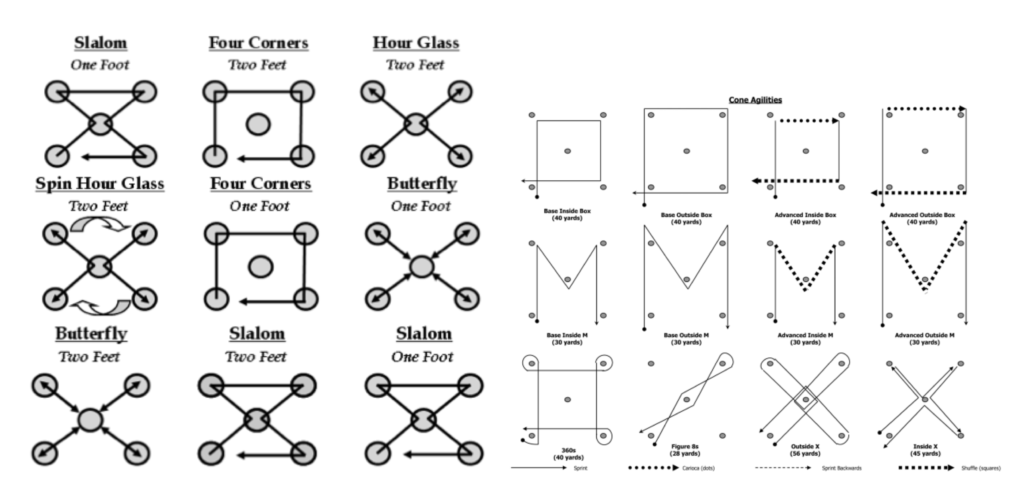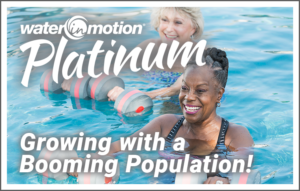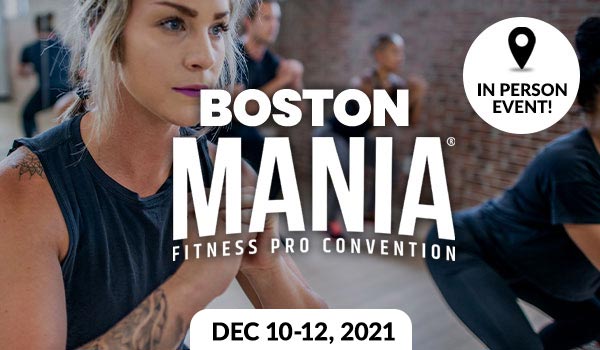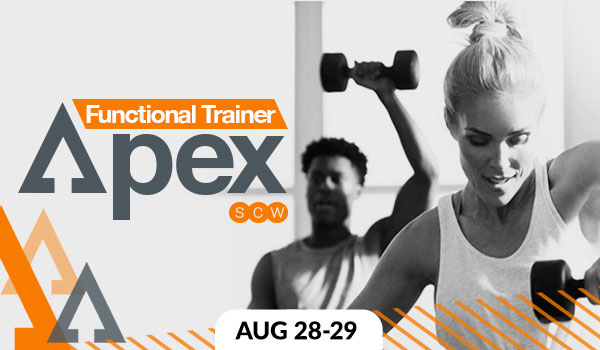
Neurobics for Purposeful Recovery
By Lori Sherlock, Ed.D.
Courtesy of Aqua Fitness Online
What are Neurobics?
- Mental exercises that challenge the brain in novel ways.
- Mental or physical activities that involve greater mental engagement or further engage the senses
Why are we Interested in Brain Health?
Cognitive decline & development of dementia or Alzheimer’s Disease
- 1 in 9 adults
- Increased risk with age
- CVD increases prevalence to 1 in 4
- Deemed public health concern by the CDC
- Increased Neural activity → increased blood flow to brain → Brain cell growth
- Increased stimulation of patterned neural activity → improved cognitive function
- Improved dual task completion
- Enhanced memory, reasoning ability, cognitive function
- Reduced risk for depression
- Reduced risk of cognitive decline and Alzheimer’s Disease
- Improved mental flexibility
- Increase in BDNF production
- Improved ability to perform ADL’s
Physical Exercise is Equally Important in Brain Health

Creating Neurobics:
- Experience unexpected, novel things
- Use your senses
- Level of importance or engagement are factors
- Evoking emotion can increase the impact
- Increasing oxygen availability can improve outcome

Intensity & Complexity:
- Increased movement complexity = reduced movement intensity
- Movement complexity is subjective
- Exercise experience, movement library, etc.
- Practicing a task reduces its perceived complexity Neurobics as purposeful recovery:
- Important to perform, bur not physically strenuous = perfect for recovery
- Ways to incorporate into recovery:
- Rest Interval during a HIIT (Immediate Recovery)
- Rest between intervals or sets (Short term recovery)
- Recovery or Transition sessions (Training Recovery)
 “It could be argued that the recovery period is equally important as the exercise stimulus” -SA Romero et.al
“It could be argued that the recovery period is equally important as the exercise stimulus” -SA Romero et.al
Importance of Recovery
- Exercise Stress → Muscle & Tissue Damage → Need for Repair → Recovery → Adaptation
- Without recovery, we can experience lack of progress with training, injury, overtraining syndrome, or burn-out
Active vs Passive Recovery
Active
- Light to moderate activity
- Can include short bouts of anaerobic activity
- Increases blood flow
- Accelerates metabolic waste removal
- Stimulates healing and adaptation
Passive
- Massage
- Compression
- Hydrotherapy
- Sleep – PARAMOUNT during training and recovery
- Intended to increase blood flow
Neurobics as Purposeful Recovery
Rest Interval during HIIT (Immediate Recovery)
- Work: Ski x :30 @ 9/10
- Rest: Write word on persons back with non-dominant hand and have them guess the word while marching x :60 @ 4/10
Rest Interval between intervals or sets (Short Term Recovery)
- Interval Set: Tabata
- Rest: Follow the Metronome (Faster → Slower)
Recovery or Transition Sessions (Training Recovery)
- REHIIT Protocol with Navigation 3 min easy
:30 sec Very Hard 3 min easy
:30 sec Very Hard 3 min easy
Neurobics for Purposeful Recovery Workout
Warm Up x 5 min
- Include 6-7 formula
- Incorporate Build-up Drill to 9/10
5 Min AE @ 5-7/10 + Word Play
1 min @ 6
- Grounded L Jack + Ski + Toe Touch
- Repeat Words of Song Out Loud
1 min @ 5
- Grounded R Jack + Ski + Toe Touch
- Repeat Tongue Twister
2 min @ 7
- Jog with directional changes and foot position changes
- Learn sign language
1 min @ 5
- Heel Taps Front and Back
- Draw letters on hand forward and back/dominant and nondominant
10 Min REHIIT Protocol – Navigation
3 minutes easy – Eyes Closed, March from your Front door to your Primary Bathroom 30 seconds VERY HARD
3 minutes easy – Eyes Closed, March from your Back Door to a landmark in your Yard 30 seconds VERY HARD
3 minutes easy – Eyes Closed, March from the Hotel’s front entrance to the Pool.
5 Min AE: Dot Drills with Direction, Dot & Foot Changes
HARD (9/10): Low-Moderate (6/10): Moderate (7/10): Easy (5/10): Low-Moderate (6/10): Easy (5/10):
1 min – 5-Dot: Slalom
1:30 min – 5-Dot: Hour Glass
1 min – 5-Dot: Figure 8 Drill
1 min – 5-Dot: Wide Triangle
1 min – 5-Dot: M Drill


5 Min AE @ 5-7/10 – Add On Memory Game
Continue to add on to the combo and the group has to remember.
- Ski x 4
- Jack Cross x 2
- Tuck & Shoot F/B x 3 + bounce center
- Clap F/B single, single, double x 2
- Tap Heels behind – Opposite x 2, same x 2
- Tap Knees in front – Opposite x 2, same x 2
- Staggered Run in a circle (right begins forward, left ends forward & reverse) x 8 Seated Level 3 scull x 8
- Karate Kick F/B/S/down x 8 (L/R)
- Tuck x 2
- Regular/Wide Twist x 2 each
- Rear Slide & pulse up x 4 c
10 Min low intensity interval set done as 1 min gentle build up 1 min mobility + ball play
- 1 min ↑ effort every 10 sec 5 → 6 → 7 → 8 (hold at 8/10 for reminder of minute)
- 1 min mobility: Clock reach with Right toes + ball
- 1 min ↑ effort every 10 sec 5 → 6 → 7 → 8 (hold at 8/10 for reminder of minute)
- 1 min mobility: Clock reach with Left toes + ball
- 1 min ↑ effort every 10 sec 5 → 6 → 7 → 8 (hold at 8/10 for reminder of minute)
- 1 min mobility:squat and reach across with ear pinch
- 1 min ↑ effort every 10 sec 5 → 6 → 7 → 8 (hold at 8/10 for reminder of minute)
- 1 min mobility: heel-toe rocks changing from neutral, internal, external + ball
- 1 min ↑ effort every 10 sec 5 → 6 → 7 → 8 (hold at 8/10 for reminder of minute)
- 1 min mobility: Figure 4 Squats + ball
 4 min low intensity interval set done as Tabatta format: Gait Focus with ball, eye and head drills
4 min low intensity interval set done as Tabatta format: Gait Focus with ball, eye and head drills
- 20 sec RIGHT Single Leg Ankle Hops Forward and Back + ball play
- 10 sec Rest
- 20 sec 3-step Pause Forward and Back + ball play
- 10 sec Rest
- 20 sec RIGHT Jump from front foot to back foot with pause – emphasize weight shift + ball play
- 10 sec Rest
- 20 sec Right/Left lateral 3-step pause + ball play
- 10 sec Rest
- 20 sec LEFT Single Leg Ankle Hops Forward and Back + ball play
- 10 sec Rest
- 20 sec 3-step Pause Forward and Back + ball play
- 10 sec Rest
- 20 sec LEFT Jump from front foot to back foot with pause – emphasize weight shift + ball play
- 10 sec Rest
- 20 sec Right/Left lateral 3-step pause + ball play
- 10 sec Rest
Cool Down x 5 min
Follow us on IG: https://www.instagram.com/scwmania/
Like our FB page: https://www.facebook.com/scwmania
Follow us on X: https://twitter.com/scw_mania
Connect with us on LinkedIn: https://www.linkedin.com/company/scwfit/
Oh, Yes You Can:
Exercise After Breast Cancer Surgery
by Ann Gilbert
Breast Cancer is the most common type of cancer in women, but according to the American Cancer Society, it has the highest survival rate of any in the books. There are numerous studies that have reviewed the effects of regular exercise in patients or clients diagnosed with breast cancer. Evidence proved that regular exercise after diagnosis improved mortality, fatigue, and overall quality of life, not to mention emotional wellbeing. Thus, exercise is now seen as a treatment in positive physiological and psychological improvements after breast cancer surgery.
General Guidelines:
After you get your “ok” from the doctor, it’s recommended to start slowly and with simple moves. A basic program includes:
- Arm Raises – Raising your arms to shoulder height and back down as many as 3-4 times a day. This type of movement allows lymph fluid to flow out of your arm area and helps to restore mobility leading to more advanced activities of daily life.
- Flexion & Extension – Flex and extend the elbow joint while seated in a comfortable chair and touch your fingers to your chest, shoulder and then over your shoulder, only if it feels comfortable. Repeat as many as 20 times and be mindful of your breathing, inhaling and exhaling, with deliberate focus on expanding the diaphragm. Stop all movement patterns if swelling or tenderness occurs.
 When participating in regular exercise there is a 50% reduced risk of recurrence in our group when compared to the sedentary groups. The benefits also include a decrease in depression and anxiety, and an increase in sleep. All of which are a challenge during the treatment weeks following surgery.
When participating in regular exercise there is a 50% reduced risk of recurrence in our group when compared to the sedentary groups. The benefits also include a decrease in depression and anxiety, and an increase in sleep. All of which are a challenge during the treatment weeks following surgery.
As a certified trainer and breast cancer survivor, I am speaking out to recommend two specific types, modes, or formats which are appropriate for survivors in weeks 4-12 post surgery. The first recommendation is to seek out a well-planned seated chair program in which each segment has a clear purpose, like S.E.A.T. Fitness. This allows the survivor to focus on mobility, postural alignment, memory, balance, and resistance training. The program should address all aspects of fitness for the patient, client or student returning to your facility or online sessions.
The use of a chair as a stabilization tool provides an increase in overall confidence as the patient restarts the fitness journey. The program you choose should incorporate a slow increase in lever, or arm length, thoracic rotation, single leg movements, and essential joint movements addressing speed, power, and even balance.
As a trainer or therapist, I suggest that developing a communication trail with the survivor’s treatment team, doctors, and oncologists. They will become immediate networking partners and providers for future clients and students.
Next, encourage starting a water fitness program, like WATERinMOTION®. The properties of buoyancy, drag, and viscosity make the aquatic environment very appropriate for the survivor. The water creates a light and playful experience, along with less self-consciousness once chest deep. Hydrostatic pressure will shorten the conditioning phase of the exercise program and aid in overall recovery.
The following movements can be completed in a chair, in the pool or when lying down in the supine position. Let’s get started.
Exercise 1. Increase the mobility of the shoulder by gently sliding a small towel up the wall while standing a few inches from the wall. If seated, gentle slide the small towel along the length of the thighs. (Repeat the movement 5-10 times.)
Exercise 2. While sitting in a chair with a lengthened spine and with weight in your heel, flex the spine from right to left, while holding your hands over your head. (Repeat the movement 5-10 times.)
 Exercise 3. Commonly called the open-door stretch, the “w” position of the arms allows for an aggressive stretch of the pectorals and a reciprocal contraction through the postural muscles of the mid back or thoracic region. Bend the elbows in what would be considered a “w”, sliding the elbows down towards the hip joint. Plank forward slightly as if to fall through an open door. Return to the starting position. (Repeat the movement 5-7 times.)
Exercise 3. Commonly called the open-door stretch, the “w” position of the arms allows for an aggressive stretch of the pectorals and a reciprocal contraction through the postural muscles of the mid back or thoracic region. Bend the elbows in what would be considered a “w”, sliding the elbows down towards the hip joint. Plank forward slightly as if to fall through an open door. Return to the starting position. (Repeat the movement 5-7 times.)
Exercise 4. Lie in the supine position with knees bent. Gently slide a ruler, wand or broom stick over the head starting at the belly. The elbows stay soft, and the focus is on increasing the range of motion at the shoulder area. While in that position one can bend the elbows and slide the fingers behind the upper back while mobbing in a wing in and wing out movement pattern. (Repeat the movement 5-7 times.)
Exercise is safe and very feasible for breast cancer survivors. I most cases, it is prescribed as a part of a treatment plan within 4-12 week of surgery. Exercise has an impact on mortality, prognosis, and overall quality of life. I recommend a multidisciplinary approach that includes both strength and aerobic exercise.
As a Survivor, I would like you all to know that early detection, aggressive nutritional change, and exercise consistency have all been instrumental in my physical and mental growth in my recovery. The word “remission” is whispered nightly as I say my amens, lay that head on the pillow and plan my exercise for the next day.
 About the Author: Ann Gilbert
About the Author: Ann Gilbert
Ann Gilbert is a Breast Cancer Survivor (in remission since June 2021), the creator and choreographer of S.E.A.T. (Supported Exercise for Ageless Training), and a master trainer for WATERinMOTION®. She is also a premier educator on exercise and aging, developing several recognized professional fitness certifications. Ann is the owner and operator of Shapes Fitness for Women, has received ACE/IHRSA Personal Trainer of the Year, and regularly presents at IHRSA, FBA-Succeed, Club Industry, SCW MANIA®, and IAFC. In her spare time, Ann spends time with her precious family and dogs.
Follow us on IG: https://www.instagram.com/scwmania/
Like our FB page: https://www.facebook.com/scwmania
Follow us on X: https://twitter.com/scw_mania
Connect with us on LinkedIn: https://www.linkedin.com/company/scwfit/
Fitness, Friends, and Wellness
for the Elderly
by Emily Conley
With advances in the field of medicine happening all around us, the elderly population is now living and working longer than ever before. According to the Population Reference Bureau (2015), the number of individuals aged 65 or older in the United States is projected to double by the year 2060 to a staggering 98 million.
Loss of muscle and bone mass are just two of the physical effects of aging, whereas the effects on mental health include an increased likelihood of being diagnosed with a mental illness. When all factors are compounded, it is no wonder that a decreased quality of life is often observed in the aging population. It is vital that medical and exercise professionals prepare for the future by investigating the best methods and mediums of physical activity for prevention and treatment for this population.
The aquatic environment is an excellent exercise modality for a variety of different populations, but many of the physical effects are especially beneficial for the elderly population. For example, the upward buoyant force of water opposes the downward force of gravity, which ultimately aids in reducing the stress load placed on the joints. This is ideal because one in two adults will experience symptoms of knee osteoarthritis at some point in their life (Arthritis Foundation). The buoyancy of the water also provides support and aids in stabilizing the body during movement. This establishes a level of comfort during walking and exercising that is not realized on land. The water also allows movement through a larger range of motion, which improves flexibility and functionality for everyday life on land.
 Improved circulation is another aspect of water immersion that is particularly beneficial. This is related to hydrostatic pressure, which increases the amount of blood being returned to the heart and ultimately provides the working muscles with more oxygenated blood. Older adults often experience reduced circulation that can cause swelling and fluid build-up in the feet. Being immersed in the water disperses this pooled fluid throughout the body.
Improved circulation is another aspect of water immersion that is particularly beneficial. This is related to hydrostatic pressure, which increases the amount of blood being returned to the heart and ultimately provides the working muscles with more oxygenated blood. Older adults often experience reduced circulation that can cause swelling and fluid build-up in the feet. Being immersed in the water disperses this pooled fluid throughout the body.
It has been noted that fear of injury is a common reason why many elderly individuals live sedentary lifestyles. The potential for falls and related injuries are significantly reduced in the aquatic environment. This offers participants an additional level of confidence when exercising and promotes a greater volume of physical activity for this population.
Not only does the elderly population benefit physically from exercising in the water, but studies show that an individual’s mental health and quality of life is also improved (Khanjari and Garooei 2015, Daisuke et al. 2007). According to the World Health Organization, 15% of adults who are 60 years of age or older have a mental disorder (WHO 2017). These disorders are often linked to feelings of distress caused by a continuous age-related decline in functional ability and independence, both of which also contribute to a decreased quality of life (World Health Organization 2017).
Group fitness classes provide many benefits that are exceptionally valuable for the mental and social health of the elderly, who are often isolated from a portion of society. This isolation results from many factors including retirement from the workplace, limited access to activities, and living alone. The community created in a local fitness class serves as a remedy for the isolation and builds important relationships. As an aquatic exercise professional, encourage the class to engage with each other by creating warm-ups that allow for interaction between participants. This builds friendships within the class, strengthens mental wellness, and also promotes adherence through a level of accountability among participants.
After examining the benefits on both physical and mental health as well as quality of life for elderly individuals, more exercise professionals should be excitedly advocating for this population to exercise in the water. While no one can stop the aging process, exercise is one of the best prescriptions for aging well.
 About the Author: Emily Conley
About the Author: Emily Conley
Emily Conley is a senior undergraduate student at West Virginia University currently studying Exercise Physiology with an emphasis in Aquatic Therapy. She is a member of the Honors College at West Virginia University. Emily has a primary interest in physical therapy and is planning to attend a PT graduate program after graduation in May 2020.
Follow us on IG: https://www.instagram.com/scwmania/
Like our FB page: https://www.facebook.com/scwmania
Follow us on X: https://twitter.com/scw_mania
Connect with us on LinkedIn: https://www.linkedin.com/company/scwfit/
Planning for 2024: SCW MANIA® Coast to Coast
Boston MANIA®, the last Pro Fitness Convention of 2023, is this weekend, November 3-5.. It’s not too late to register for 15 in-person aqua sessions and 15 pre-recorded water workshops along with over 200 lectures and classes ranging from HIIT, Active Aging, Small Group Training, Mind Body, Cycle, Nutrition, and Business. Can’t make it, either purchase the session recordings or come join us in 2024 at the other SCW MANIA® starting in DC and continuing on to California, Florida, Atlanta, Dallas, Midwest, and back to Boston. Save $100 on registration with code SCARE!
Follow us on IG: https://www.instagram.com/scwmania/
Like our FB page: https://www.facebook.com/scwmania
Follow us on X: https://twitter.com/scw_mania
Connect with us on LinkedIn: https://www.linkedin.com/company/scwfit/
Looking To Hire? FREE Job Board
In Need of Teachers, Trainers, Directors, or Managers? SCW’s new FREE JOB BOARD is supporting the industry’s need for qualified fitness pros.
Best of all there is NO COST to you. We will post your openings in all three of our monthly e-newsletters: Spotlite, Health & Fitness Business News, and Tidal Waves which are emailed out to tens of thousands of fitness professionals teaching and training in all formats along with managers and directors at all fitness facilities: big box, gyms, boutique, studios, not for profits and independent centers.
Follow us on IG: https://www.instagram.com/scwmania/
Like our FB page: https://www.facebook.com/scwmania
Follow us on X: https://twitter.com/scw_mania
Connect with us on LinkedIn: https://www.linkedin.com/company/scwfit/
We’re always looking for great content highlighting the newest things in the world of aquatic fitness. Please submit your article directly to [email protected] for immediate consideration!
Give us your feedback on what interests you, and maybe YOU will make it in the SCW Tidal Waves!
Tidal Waves, January 2024
Tidal Waves, December 2023
Tidal Waves, November 2023
Tidal Waves, October 2023
Tidal Waves, September 2023
Tidal Waves, August 2023
Tidal Waves, July 2023
Tidal Waves, June 2023
Tidal Waves, May 2023
Tidal Waves, April 2023
Tidal Waves, March 2023
Tidal Waves, January 2023
Tidal Waves, November 2022
Tidal Waves, September 2022
Tidal Waves, July 2022
Tidal Waves, June 2022
Tidal Waves, May 2022
Tidal Waves, April 2022
Tidal Waves, March 2022
Tidal Waves, February 2022
Tidal Waves, January 2022
Tidal Waves, November 2021
Tidal Waves, October 2021
Tidal Waves, August 2021
Tidal Waves, July 2021
Tidal Waves, June 2021
Tidal Waves, May 2021
Tidal Waves, April 2021
Tidal Waves, March 2021
Tidal Waves, January 2021
Tidal Waves, November 2020
Tidal Waves, September 2020
Tidal Waves, July 2020
Tidal Waves, February 2020
Tidal Waves, November 2019

















